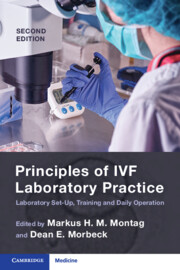Book contents
- Principles of IVF Laboratory Practice
- Principles of IVF Laboratory Practice
- Copyright page
- Contents
- Contributors
- Foreword
- The Evolution of IVF Practice
- Section 1 Starting a New Laboratory and Training Protocols
- Section 2 Pre-procedure Protocols
- Section 3 Gametes
- Section 4 Insemination/ICSI
- Section 5 Fertilization Assessment
- Section 6 Embryo Assessment: Morphology and Beyond
- Chapter 29 Polar Body Biopsy for IVF
- Chapter 30 Embryo Assessment at the Pre-compaction Stage in the IVF Laboratory
- Chapter 31 Embryo Assessment at the Post-compaction Stage in the IVF Laboratory
- Chapter 32 Embryo Assessment at the Blastocyst Stage in the IVF Laboratory
- Chapter 33 Trophectoderm Biopsy for Pre-implantation Genetic Testing
- Chapter 34 Embryo Culture by Time-Lapse: Selection and Beyond
- Section 7 Embryo Cryopreservation
- Section 8 Embryo Transfer
- Section 9 Quality Management
- Index
- References
Chapter 33 - Trophectoderm Biopsy for Pre-implantation Genetic Testing
from Section 6 - Embryo Assessment: Morphology and Beyond
Published online by Cambridge University Press: 07 August 2023
- Principles of IVF Laboratory Practice
- Principles of IVF Laboratory Practice
- Copyright page
- Contents
- Contributors
- Foreword
- The Evolution of IVF Practice
- Section 1 Starting a New Laboratory and Training Protocols
- Section 2 Pre-procedure Protocols
- Section 3 Gametes
- Section 4 Insemination/ICSI
- Section 5 Fertilization Assessment
- Section 6 Embryo Assessment: Morphology and Beyond
- Chapter 29 Polar Body Biopsy for IVF
- Chapter 30 Embryo Assessment at the Pre-compaction Stage in the IVF Laboratory
- Chapter 31 Embryo Assessment at the Post-compaction Stage in the IVF Laboratory
- Chapter 32 Embryo Assessment at the Blastocyst Stage in the IVF Laboratory
- Chapter 33 Trophectoderm Biopsy for Pre-implantation Genetic Testing
- Chapter 34 Embryo Culture by Time-Lapse: Selection and Beyond
- Section 7 Embryo Cryopreservation
- Section 8 Embryo Transfer
- Section 9 Quality Management
- Index
- References
Summary
Trophectoderm (TE) biopsy is the gold standard for collecting embryo specimens for pre-implantation genetic testing (PGT). Because TE biopsies contain approximately 5–10 cells they provide a more robust template for DNA amplification, increasing diagnostic efficiency and representativeness of the whole embryo chromosomal constitution compared to a single cell biopsy. TE biopsy requires superior micromanipulation skills. Technical aspects include the combination of laser technology and micromanipulation to detach the biopsied specimen from the blastocyst. TE biopsy can be achieved employing different approaches according to the blastocyst’s characteristics and laboratory setting. Biopsy tubing entails a high degree of manual skills and coordination. In order to reach a highly efficient PGT program, blastocyst culture, biopsy and tubing technique, as well as robust cryopreservation processes are required.
- Type
- Chapter
- Information
- Principles of IVF Laboratory PracticeLaboratory Set-Up, Training and Daily Operation, pp. 240 - 250Publisher: Cambridge University PressPrint publication year: 2023



